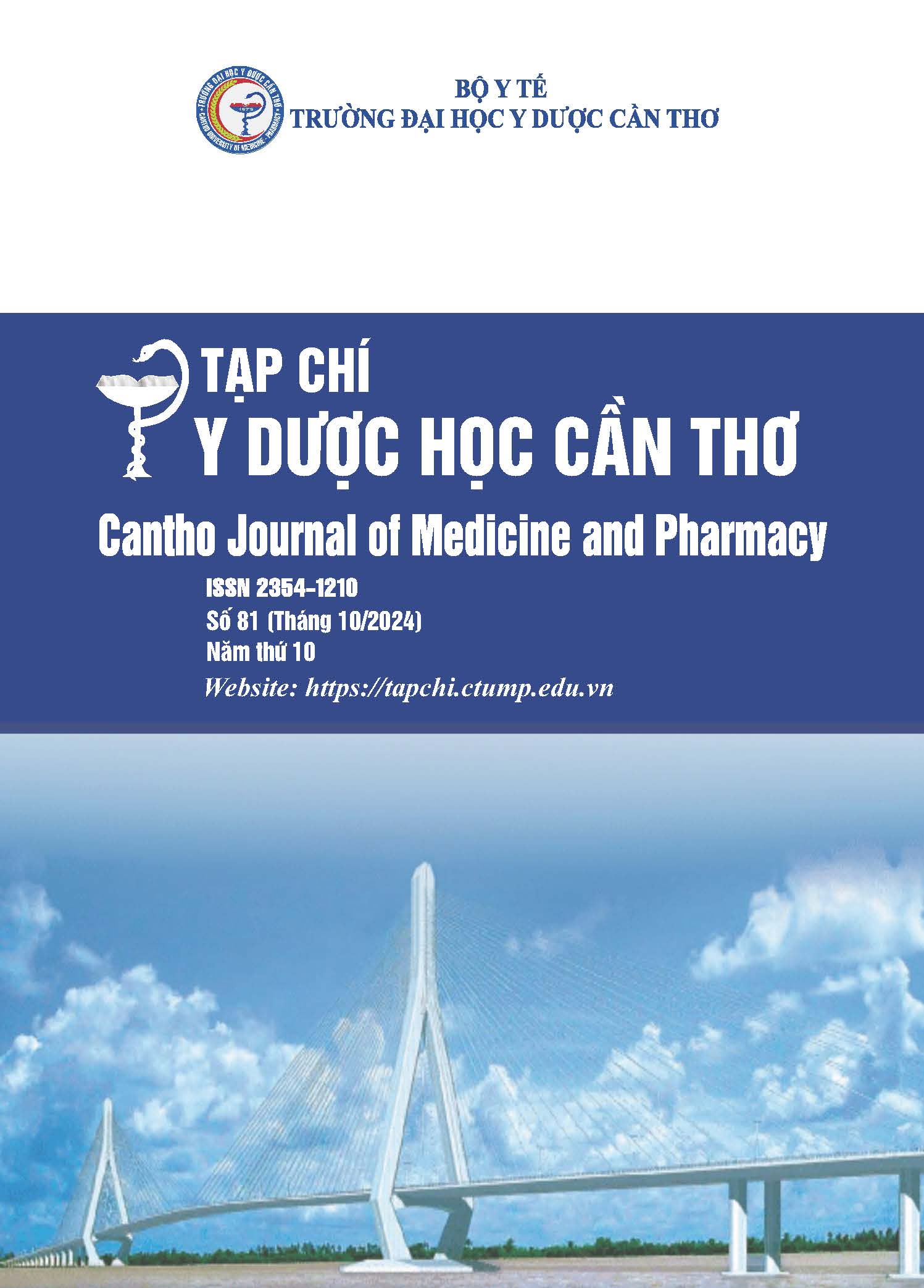SYNTHESIZE AND EVALUATE THE ANTIBACTERIAL AND ANTIFUNGAL ACTIVITY OF HEXYLOXYPHENYL-1,3,4-OXADIAZOLE DERIVATIVES
Main Article Content
Abstract
Background: Based on the outstanding properties of natural antibacterial peptides, small molecule cationic amphipathics have been considered as potential drug development research to find novel antibacterial and antifungal agents. Based on the core structural characteristics of amphiphilic cationic antibacterial agents, the 1,3,4-oxadiazole ring that appears in many antibacterial agents was choosen to design, synthesize, and evaluate its antibacterial and antifungal activities. Objectives: To synthesize hexyloxyphenyl-1,3,4-oxadiazole derivatives and study the antibacterial and antifungal activity. Material and methods: Hexyloxyphenyl-1,3,4-oxadiazole derivatives were synthesized from the starting material 4-hydroxybenzaldehyde, then forms a 1,3,4oxadiazole ring before attaching to amino acids to obtain cationic small amphiphiles. The structures were determined by 1H NMR and 13C NMR. For testing antibacterial and antifungal activities: Microdilution method in liquid medium using broth on a 96-well plate. Result: Three hexyloxyphenyl-1,3,4-oxadiazole derivatives were synthesized. Tested activity on two bacterial strains and one fungal strain; The three synthesized substances did not show activity on the tested strains at a concentration of 128 µg/mL. Conclusion: The three hexyloxyphenyl-1,3,4-oxadiazole derivatives synthesized show non-antibacterial and non-antifungal activity on the investigated strain at a 128 µg/ml concentration. It is necessary to continue researching the synthesis of the more novel derivatives and evaluate the effects on new strains of microorganisms.
Article Details
Keywords
hexyloxyphenyl-1,3,4-oxadiazole, small molecule amphiphilic, antibacterial, antifungal
References
2. Bahar AA, Ren D., Antimicrobial peptides. Pharmaceuticals (Basel) 2013. 6:1543–75, DOI: 10.3390/ph6121543.
3. Zanetti M. Cathelicidins, multifunctional peptides of the innate immunity. J Leukoc Biol. 2004.
(75), 39–48, DOI: 10.1189/jlb.0403147.3.
4. Hancock, R. E., G. Diamond, The role of cationic antimicrobial peptides in innate host defences. Trends Microbiol. 2000 (8). 402–410, DOI: 10.1016/s0966-842x(00)01823-0.
5. Starr CG, Maderdrut JL, He J, Coy DH, Wimley WC. Pituitary adenylate cyclase-activating polypeptide is a potent broad-spectrum antimicrobial peptide: structure-activity relationships. Peptides. 2018. (104), 35–40, DOI: 10.1016/j.peptides.2018.04.006.
6. Charles H. Chen Timothy K. Lu, Development and Challenges of Antimicrobial Peptides for Therapeutic Applications, Antibiotic. 2020. 9(1), 24, DOI: 10.3390/antibiotics9010024.
7. Hamamoto, K., Kida, Y., Zhang, Y., Shimizu, T., Kuwano, K., Antimicrobial activity and stability to proteolysis of small linear cationic peptides with D-amino acid substitutions. Microbiol. Immunol. 2002. 46, 741–749, DOI: 10.1111/j.1348-0421.2002.tb02759.x.
8. Qiu Y. L., Fui M. Ng, Jin D. C., Yi Y. Y., Yoke Y. T., Discovery of an ultra-short linear antibacterial tetrapeptide with anti-MRSA activity from a structure–activity relationship study, European Journal of Medicinal Chemistry. 2025. Vol. 105, 138-144,
DOI: 10.1016/j.ejmech.2015.10.015.
9. Sandeep L., Swaranjit S.C., Gopal S.B., Antibacterial evaluation of structurally amphipathic, membrane active small cationic peptidomimetics: Synthesized by incorporating 3-amino benzoic acid as peptidomimetic element, European Journal of Medicinal Chemistry. 2014. Vol. 83, 102-115, DOI:10.1016/j.ejmech.2014.06.023.
10. Bakka, T. A., Strøm, M. B., Andersen, J. H., Gautun, O. R., Methyl propiolate and 3-butynone: Starting points for synthesis of amphiphilic 1,2,3-triazole peptidomimetics for antimicrobial evaluation, Bioorganic & Medicinal Chemistry. 2017. 25(20), 5380–5395,
DOI: 10.1016/j.bmc.2017.07.060.
11. Bai P.Y., Qin S.S., Chu W.C., Yang Y., Cui D.Y., et al., Synthesis and antibacterial bioactivities of cationic deacetyl linezolid amphiphiles, European Journal of Medicinal Chemistry. 2018. 155, 925–945, DOI: 10.1016/j.ejmech.2018.06.054.
12. Cledualdo S.D.O., Bruno F.L., Jose M.B.F., Jorge G.F.L., Petronio F.D.F, Synthetic Approaches and Pharmacological Activity of 1,3,4-Oxadiazoles: A Review of the Literature from 2000–2012, Molecules. 2012. 17(9), 10192-10231, DOI: 10.3390/molecules170910192.
13. Juan S., Jigar A.M, Hai L.Z., 1,3,4-oxadiazole derivatives as potential biological agents, 2013, Mini Rev Med Chem. 2013. 13(12), 1725-43, DOI: 10.2174/13895575113139990071.
14. Cédric T., Richard R., Rafael G.V.B., Marion T., Hong H.L, et al., Synthesis and evaluation of 1,3,4-oxadiazole derivatives for development as broad-spectrum antibiotics, Bioorganic & Medicinal Chemistry. 2019. 27(21):115097, DOI: 10.1016/j.bmc.2019.115097.
15. George A. N., Nader S.A, Kenneth I.O., Mohamed N.S., Herman O.S., Potent trifluoromethoxy, trifluoromethylsulfonyl, trifluoromethylthio and pentafluorosulfanyl containing (1,3,4oxadiazol-2-yl) benzamides against drug-resistant Gram-positive bacteria, RSC Med. Chem.,2020. 11, 102-110, DOI: 10.1039/c9md00391f.
16. Pengfei N., Jinfeng K., Xianhai T., Lina S., Hongxu L., et al., Synthesis of 2-Amino-1,3,4oxadiazoles and 2-Amino-1,3,4- thiadiazoles via Sequential Condensation and I2-Mediated Oxidative C−O/C−S Bond Formation, J. Org. Chem. 2015. 80, 1018−1024, DOI:10.1021/jo502518c.
17. Melvin P.W., James S.L., April M.B., Shelley C., Sharon K.C., et al., Clinical and Laboratory Standards Institute, M100 Performance Standards for Antimicrobial Susceptibility Testing. 2020. 54-62, DOI: 10.1128/JCM.01864-19.


